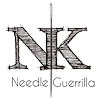The same is valid
for men as it is for women but in regard to fashionable attire perhaps
to a lesser extent. As you will see on the next page with its gallery,
men tended to be even ore old fashioned. It probably had to do with the
fact that long hose were more comfortable and convenient for working as
a farmer than breeches.
Information on fabrics
and available colours for the common people is important, to be able to
take the step in the next lesson towards the affluent classes.
Fabrics used in the
period can be divided into two main categories, wool and linen with some
combination materials and a small amount of silk and even cotton at this
social level. The higher levels of society would wear in the 1660s a vast
amount of silks, it is the time before brocades became most fashionable
at the decade of smooth and stiff silk taffetas. The vast majority of
textiles, may it be cheap or expensive ones, would have been produced
commercially. Large scale sheep farmers in England were selling their
fleece to merchants who moved it to other areas of the country for processing.
Looms were large pieces of equipment requiring space and weaving was a
more or less full time occupation. It was very often done in the home
though but those people were still full time weaving, though domestically
for an outside market. There is little indication from farm inventories
of farmers growing hemp or flax and much of the linen used was imported
from Scotland or the continent as can be seen in such names as Scottish,
Osnaburg, Camric (Cambray), Holland etc.
Woollen
Fabrics
Frieze and Rugs
Commonly mentioned in connection with gowns on this and used for the outer
layer and skirts. Frieze was produced in different qualities, with the
cheapest coarse, but since it was thicked and fulled, a very warm fabric,
and the most expensive one being fine and very fashionable, as according
to Thomas Fuller in his The History of the Worthies of England from
1662.
Serge
Often referred to as worn by the poorer classes both by men and women,
on account of durability more than on price. Nowadays serge is a very
durable twilled cloth of worsted. Fuller mentions:
"Taunton serges
are eminent in their kind, being a fashionable wearing, as lighter than
cloth, yet thicker than many other stuff."
Sayes and Bayes
A coarse woollen stuff having a long nap nowadays. In the 17th century
it was made of finer and lighter texture and used as clothing material.
Frizado
Heavy worsted cloth similar to baize.
Stuffs
A general term applied to a variety of woollen fabrics certainly including
bays and says and serges.
Broadcloth
There was a variety of specifications for cloth, used generally for outer
garments and similar to greatcoat or modern day duffel coat weights. There
appears little evidence for use of broadcloth in women's clothing which
is generally of lighter wool or linen material. Cloaks may be an exception.
Russet
There are two meanings to the word. One is a homespun cloth, the other
a reddish brown or grey colour. It should be emphasised that this is homespun
and not home woven. Many paintings show women at home at the spinning
wheel, but none show them weaving. Spinning was apparently not done anywhere
else but in the home. The lower class the household was the more likely
that spinning was done commercially to supply merchants and thus supplement
the income. It is probable that russet was not a specific type but more
a generic feel for a style of cloth.
Kersie
Kersies were a kind of coarse narrow cloth, woven from long wool and usually
ribbed. This was a good quality cloth to the lower classes and probably
used for their best clothes.
Flannel
Welsh made woollen fabric made of woollen yarn slightly twisted and-open
textured, plain or twill weave.
Fustians
Fustians are combination fabrics and made in Lancashire. Cotton, wool
or yarn brought from overseas, cloth used by poor people for their outsides
and by their betters for linings according to Fuller.
Linen
Housewife Cloth
Linen cloth that is made in England and of many varieties and qualities.
It is the usual linen that a servant or working person would buy.
Holland
Holland came in various types as well and was imported from the low countries.
Fleazey was a strong but soft cloth much used for shirts, forehead cloths
and handkerchiefs.
Cambric and cambric lawn were the best and finest linens.
Lockram
Made from hemp it was used to make shirts.
Canvas
A strong cloth made originally from hemp.
Buckram
A coarse cloth of linen or hemp stiffened with seize, used in garments
to keep them in shape. Not to be mistaken with the modern day buckram
for millinery, which is much too stiff.
Taffeta
A term applied to various kinds of silks and linens although it originally
meant only the weave.
Calico
Used rarely for aprons and bedding. The strongly coloured aprons in the
paintings may be made from this.
Fabric
Colours
The principle bulk dyes for cloth were woad for blue, madder for red and
weld or dyers broom for yellow and oak galls for black. Grey and white
were often undyed. Linens were usually bleached, which can be seen in
a painting from the period which depicts a village's bleaching lawn with
all the linens spread out in the sun. Some conclusions can be drawn about
colour, particularly when studying period paintings. There is a great
amount of certain colours like red and blue, as well as browns, which
did not have to be dyed.
Buttons
Buttons were made in a variety of ways. Cast pewter buttons were hollow
and usually round and domed. A second variety is made from scraps of cloth,
a small piece is rolled into a ball and covered by a second piece. A metal
shank may be inserted but these buttons do last well even when merely
sewn onto the garment. A third alternative is a wooden bead but they are
losing importance in this period.
Thread
Evidence from Irish bog burials shows that linen and woollen sewing threads
were used.
Fur
mentioning of fur occurs only occasionally and when it does the hulk of
it is rabbit fur All the women's jackets which are fur edged seem to be
using rabbit fur. White being the favourite colour. |









